The decision to purchase a new piano need not require a major investment. In fact, there are many reasonably-priced options for those who choose a keyboard piano. The top 10 affordable keyboard pianos for 2023 include offerings with a wide range of prices, features and capabilities.
Contents
- 1. Casio SA-77 44 Key Mini Personal Keyboard
- 2. RockJam 61-Key Electronic Keyboard Piano SuperKit
- 3. Alesis Melody 61 MKII – 61-Key Portable Keyboard
- 4. Hamzer 61-Key Electronic Piano Electric Organ Music Keyboard
- 5. Alesis Recital 88-Key Beginner Digital Piano
- 6. LAGRIMA Electric Piano Keyboard, 61 key Keyboard Music Piano
- 7. Plixio 61-Key Digital Electric Piano Keyboard
- 8. Casio Privia PX-160BK 88-Key Full Size Digital Piano
- 9. Kawai ES100 88-key Digital Piano with Speakers
- 10. Yamaha P45 88-Key Weighted Action Digital Piano
- Keyboard Piano Selection Tips
- Types of Keyboard Pianos
- Top Keyboard Piano Brands
1. Casio SA-77 44 Key Mini Personal Keyboard
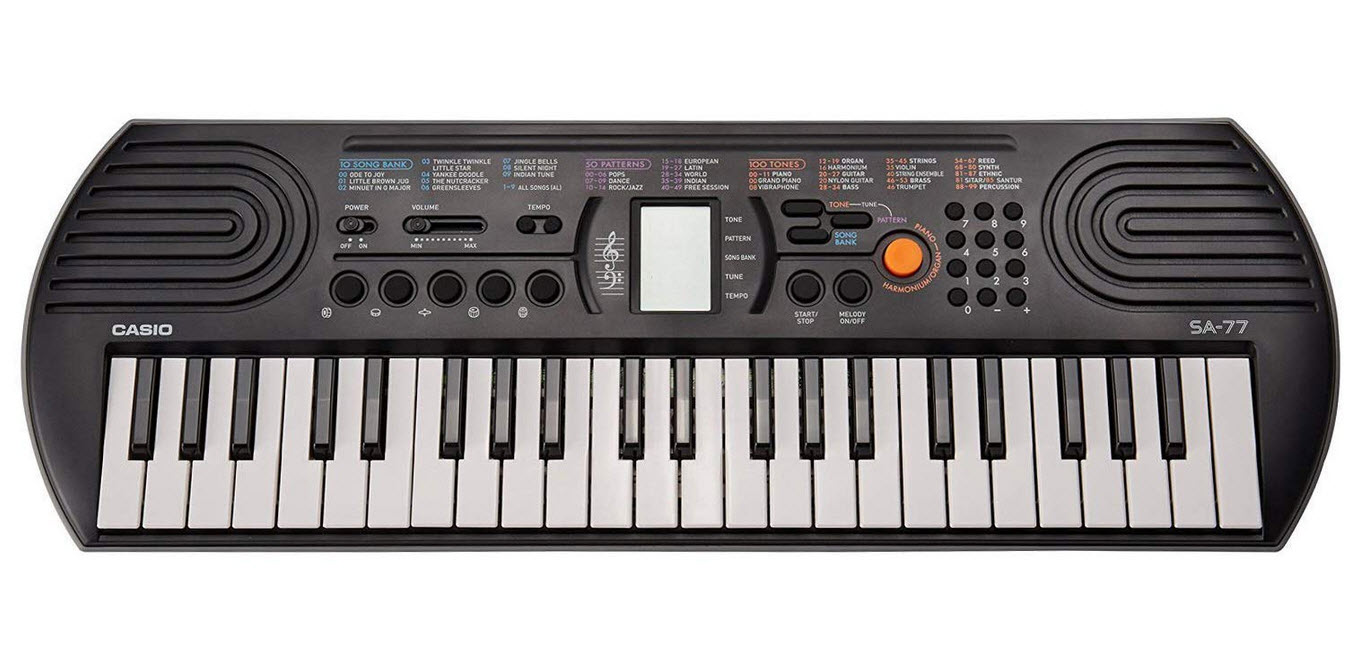
Features/Pricing/Description:
Priced right at $49, this keyboard comes with 100 tones, and LC display, fifty rhythms, 5 drum pads and an “organ/piano” button to switch settings. For players who want to learn the piano, there are even ten songs integrated for ease of study. Good sound quality and a nicely functional LC display that allows users to choose and request all the different musical options. The change switch lets players pick whether they want to use piano mode or organ mode. This product offers kids and beginners a fun, inviting way to learn.
Pros
-Decent amount of pre-programmed music
-Portable
-Quality audio
-Very easy to use
-Responsive keys
Cons
-Somewhat limited selection of sounds
-Not advanced enough for many players
2. RockJam 61-Key Electronic Keyboard Piano SuperKit
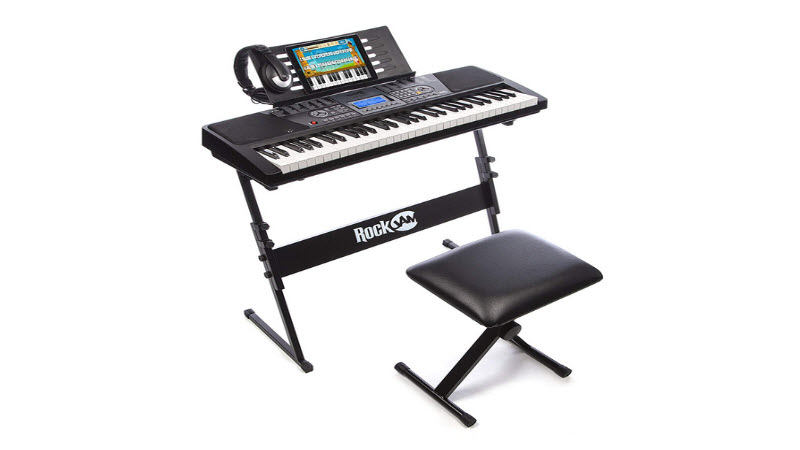
Features/Pricing/Description:
This keyboard piano is great for new players and life-long learners but has the ability to adapt to more advanced players as well. In fact, it boasts enough diverse features that it can even work as a stage instrument for bands or solo performers.
There are lots of effects so those who wish to record their own music and songs can do so. The design lends itself to having fun and leaning at the same time. This product is much more than a “toy.” With multiple instrument voices, creative players can easily add background instruments to any track. The 61 keys and other features make it an ideal choice for students who are serious about learning piano.
All you need is an electrical outlet and you’re ready to learn and play anywhere because the keyboard is lightweight and portable. Features include record/playback function, an ample LCD screen, rhythms, full-size keys, voices, and there’s a great bundle package that includes stand, bench and headphones.
Pros
-Priced right for a learner piano
-Includes voices and multiple effects
-Adequate for stage and performance use
-Convenient: Plugs in anywhere, very lightweight
Cons
-Full volume is the default
-Only works with iPad or iPhone
-No USB connection
-No pedal port
3. Alesis Melody 61 MKII – 61-Key Portable Keyboard
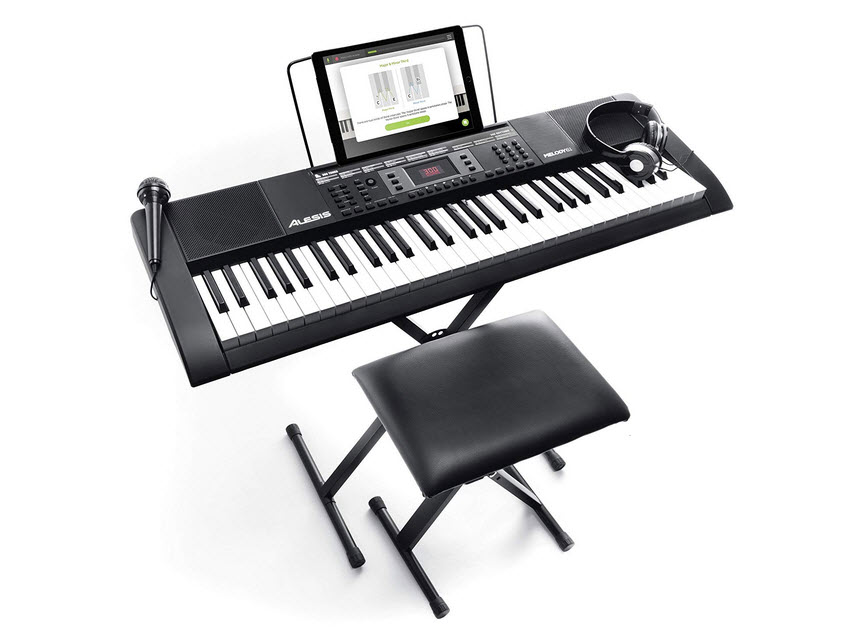
Features/Pricing/Description:
The designers of this keyboard hit the sweet spot. It’s tailored for older children and young adult learners who don’t want a “toy” piano. It’s even ideal for young kids who have a true desire to learn to play because it has plenty of functions and accessories that give that “real piano” feeling the very first time it’s played.
For starters, this product is a genuine value at just $99, features a 61-key layout, 300 rhythms for accompaniment, and the same number of instrument voices as well. The included items are generous, with headphones, bench, keyboard stand, music rest and a mic. The keyboard allows users to record songs and immediately listen to them via the playback feature. Budding musical talents will appreciate the relevant functionality of this bargain of a keyboard.
There’s also a layer mode function, known as “dual keyboard” here for simultaneously playing two separate instruments. The 40 demo songs are built-in for simple use, study and imitation. Runs on batteries or AC electric plug-in power.
Pros
-Enough keys for full practice capability
-300 accompaniment rhythms and the same number of instrument sounds allow for creative learning and musical exploration
-40 demo songs are built-in
-Dual keyboard mode
-Record and playback capability
-Includes lots of extras as well as 3 months of Skoove Premium
-Also comes with a microphone
Cons
-No digital or USB connection capability
-The sound quality of the instrument voices is lacking
-Microphone can’t be adjusted and has volume set too high for most tastes
4. Hamzer 61-Key Electronic Piano Electric Organ Music Keyboard
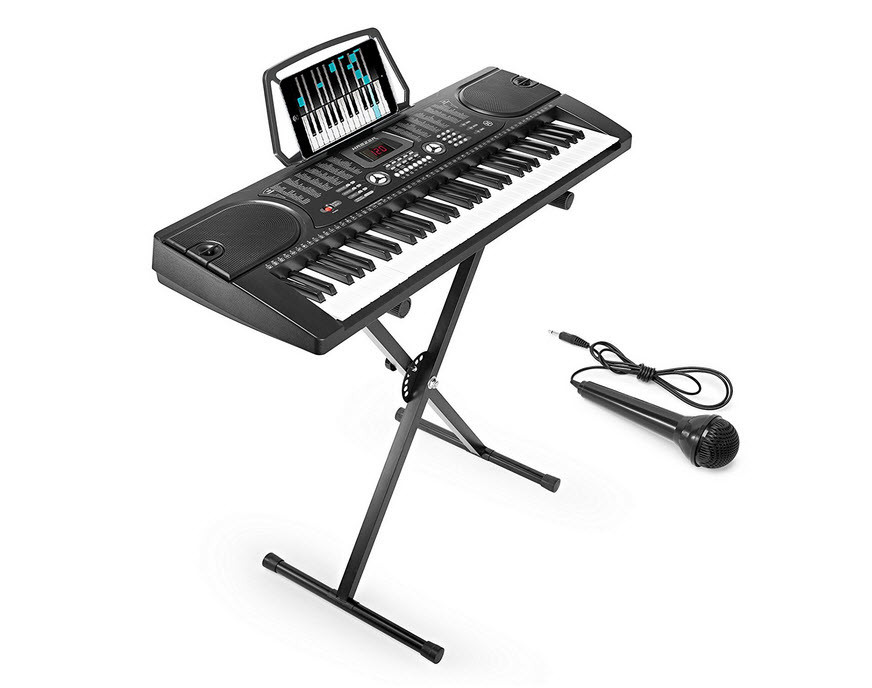
Features/Pricing/Description:
Priced at a very reasonable $86.99, this popular selection for many new players is a 61-key bargain. It comes with stool, mic, stand, and headphones for starters, and has high-quality sound for the price point. Some of the reasons this is an ideal piano keyboard for learners and even advanced players include the speakers, which are 255-timbre capable. Other features are the keyboard percussions, which number 61 in total, the 255 rhythms, and two dozen demo songs for all playing levels. External speakers let users show their stuff, or players can choose to just wear the headphones and listen in private.
This piano keyboard makes it easy for new learners to understand the nuances of finger control through the unique integrated learning system. This mode is suitable for all players up to the intermediate level. There’s even a master-volume control, as well as rhythm sync, easy to adjust tempo settings, and a clear LCD display.
Pros
-Perfect for learners up to intermediate level
-Simple record/playback features for easy editing and review
-Includes lots of extras: microphone, four-foot cord, audio output/input, headphones
-AC power adapter for plug-in use, but it also runs on 6 AA batteries
-Tough stand with variety of height settings
-255 timbres, 61 percussions, 255 rhythms
-Tempo adjustment, rhythm sync
-Ultra-simple record and playback function
Cons
-Mid-level students might find the 61-key setup limiting as they advance in their skills
-Keys are not standard size
-Keys are not weighted
-There are no pedals
5. Alesis Recital 88-Key Beginner Digital Piano
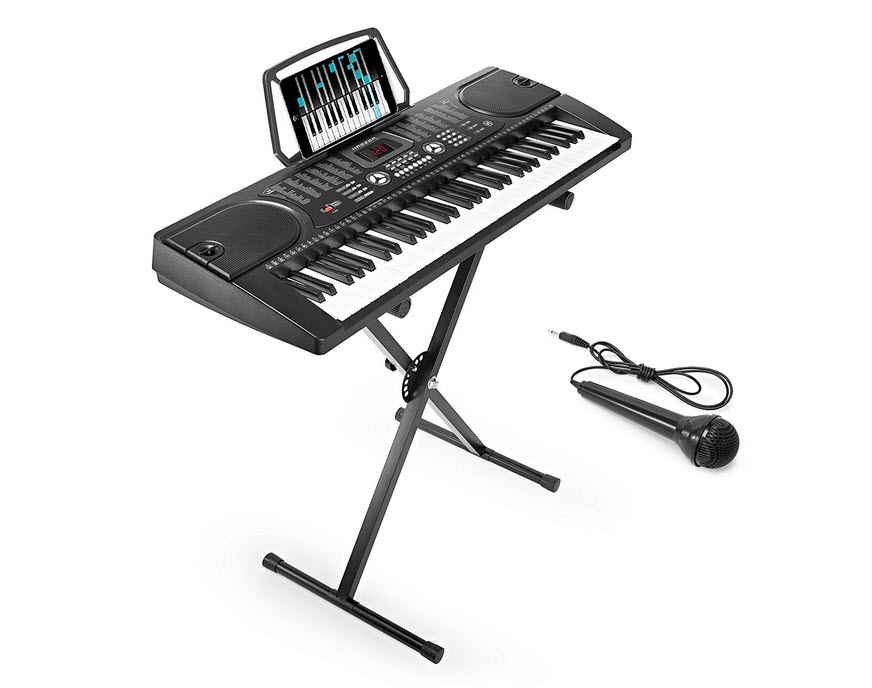
Features/Pricing/Description:
Prices just above the $200 point at $209.99, this capable keyboard piano includes a full set of 88 keys and five piano voices built into its tech. The voices are both realistic and clear, while the semi-weighted keys include a clever method for users to obtain a realistic sensory experience: the “touch-response” capability. The metronome is adjustable and the lesson modes are built in, which makes this product one of the better ones for those just starting out with piano lessons and even students at the intermediate level.
Pros
-Rich tone with voice customization
-There’s a teacher-student split keyboard function that’s ideal for lessons
-Synth, organ, electric, acoustic and bass voices are built in
-There’s a digital recital function for those who take online, interactive lessons
Cons
-The built-in speakers are quite small and deliver lower-quality sound than the headphones
-Offers fewer features than most other similarly-priced keyboard pianos
-Not as user-friendly as it could be
-Manual is essential for users due to non-intuitive setup of many functions
6. LAGRIMA Electric Piano Keyboard, 61 key Keyboard Music Piano
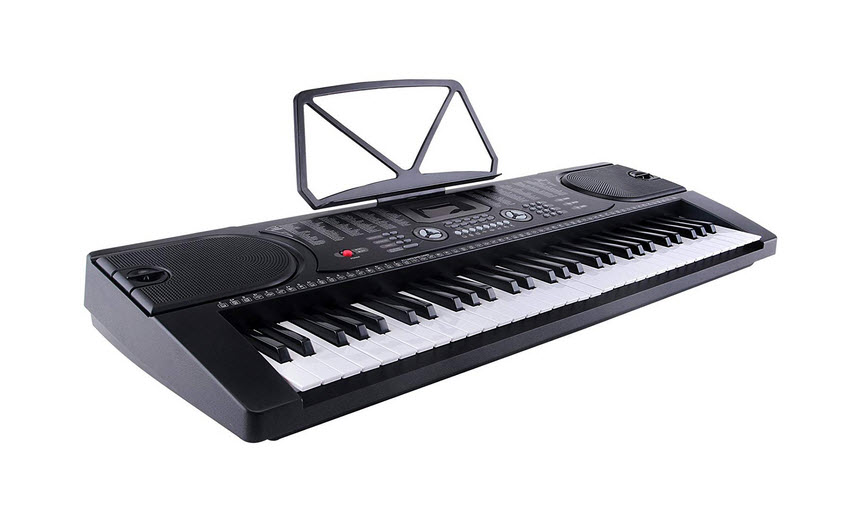
Features/Pricing/Description:
For beginner and intermediate learners, this $50.99 product is a bargain among the less pricey choices. The keys are arranged well, respond to touch adequately and are soft. Key surface is quite smooth and even the texture is a welcome feature for beginners who need to learn sensory connection. The operation is simple and designed to be intuitive, especially for beginners. For example, anyone can quickly learn how to use the programming function, the record/playback mode, and other learning enhancement features.
The H-shaped stand is part of the package, as are the 200-timbre capability, 128 rhythms, and a diverse set of ten demo songs. There’s even a double-keyboard feature for easy lesson work alongside a teacher or tutor.
Pros
-Includes a fully functional bench
-Features 10 demo songs
-Comes with 128 rhythms and 200 timbres
-Ideal and intuitive for beginners
-Designed to encourage learning and regular progress
-Double keyboard mode is perfect for lessons
Cons
-Sound quality could be better, even considering the price point
-Connectivity is quite limited
-Aesthetically rather plain for some tastes
-Keys tend to be too sensitive and are not full size
-Beginners quickly outgrow this keyboard in some cases
-When plugged in, there can be a low electrical whining noise at times
7. Plixio 61-Key Digital Electric Piano Keyboard
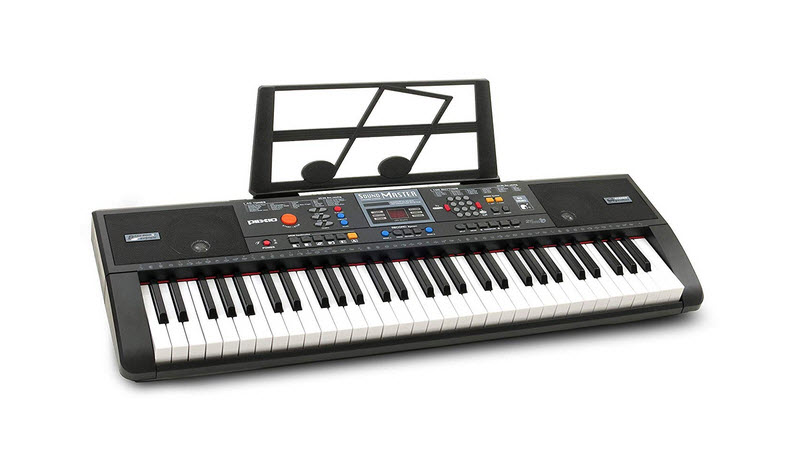
Features/Pricing/Description:
A solid value for $64.99, this full-size keyboard piano is an electrical wizard. It boasts MP3 and USB input for intermediate and advanced players who want to sharpen their skills. Designed for the boundary line area between beginner and intermediate players, this piano is fully functional even for those beyond the intermediate levels but is not so overwhelming for new learners either. That’s the beauty of its design, and is an aspect that many other keyboard electric pianos lack.
The keyboard is simple to use for learning songs, acquiring new skills and even experimenting as you move through the learning curve that every beginner faces. Playing performance is impressive for a 61-key model. The piano can be fully customized via the MP3 input and the included USB port so that any performance can become unique.
The keys are full size, which is a big advantage for those who will move on in their skill development on a standard piano. The keys on this model carry just the right amount of firmness and are realistically responsive. The in-tune sound is a welcome aspect for beginners and more advanced players.
The lesson mode runs from “pure beginner” level to a challenging engagement of skills for players up to early-advanced abilities. There’s even a built-in stand for sheet music, situated on top of the unit to prevent sore neck and shoulder muscles. This feature promotes appropriate “piano posture” in beginners, an essential part of learning.
Pros
-Keys are highly responsive and ideal for beginners
-The unit is easily portable
-The demonstration songs are easy to use
-You can record the music as you play it
-Includes a fully functional power cord
-There are multiple rhythms built in
-There is a vast selection of music that users can choose from
Cons
-There is not an included stand with the keyboard
-Some advanced players might find the functions limited
8. Casio Privia PX-160BK 88-Key Full Size Digital Piano
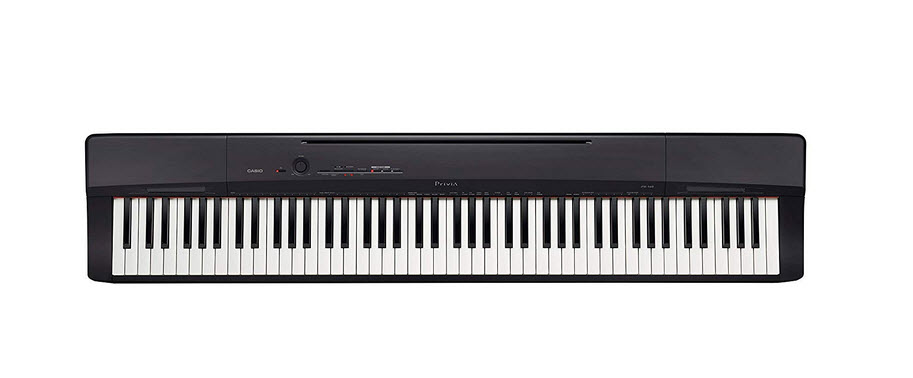
Features/Pricing/Description:
For a keyboard piano at one of the higher price points, $499, this unit delivers the goods. Its generous bundle includes an almost-like-a-grand functionality, top polyphony at 128 with a full set of built-in tones numbering 18, including classic mode, modern mode and more.
Pros
-Lightweight
-Aesthetically designed to look great in any room and in any home
-Overall music quality is better than most any selection in the keyboard piano product segment
Cons
-The one downside users have noted is that the bench is not adjustable
9. Kawai ES100 88-key Digital Piano with Speakers

Features/Pricing/Description:
For $729.99, consumers expect a lot from a keyboard piano, and with this model they get their money’s worth. This easy-to-transport model includes an incredibly responsive keyboard as well as a set of onboard controls that are intuitive and ideal for beginners and more advanced players. The keys are graded and weighted so that they are almost impossible to distinguish from the real thing on an acoustic piano.
Pros
-Simple, intuitive interface
-Very easy to transport
Cons
-The sound quality could be better
-The speaker is not of the highest quality
-The range of functions is somewhat limited
10. Yamaha P45 88-Key Weighted Action Digital Piano
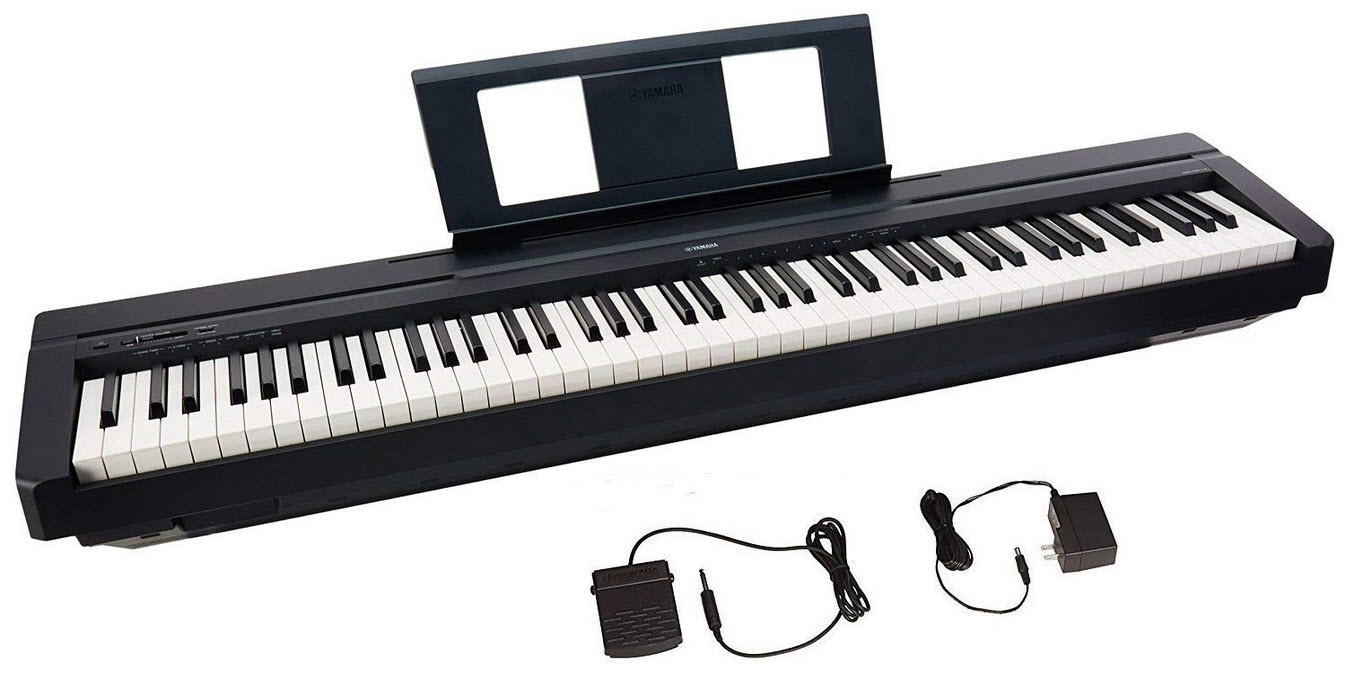
Features/Pricing/Description:
Prices at $449.99, this keyboard offer superior quality all around, with a well-designed keyboard that works for all skill levels. This full-size unit has been designed to let users get as close as possible to the feel of an acoustic instrument. Has 88 weighted keys, dual and duo mode, a pair of 6W speakers, polyphony of 64 notes, stereo sampling of AWM, multiple touch-sensitive options. Other features include: Excellent key traction, sturdy unit, 10 instrument sounds, full sustain-jack, headphone and USB connectivity, a fine-tuning, transpose metronome.
Pros
-Lightweight
-Simple to use controls
-10 authentic voices included
-Sampling technology (advanced wave memory)
-Superior key traction
-Solid, sturdy overall construction
Cons
-Lacks “aux” output
-Lacks ability to do track recording
Keyboard Piano Selection Tips
You’ve thought about it for a while, and now you’re itching to get your hands on a brand new keyboard. To help you get the most value for your money when selecting a keyboard piano, pay attention to the following factors:

-Touch response: Also known as touch sensitivity, this refers to the ability to adjust note volume depending on how hard the keys are struck. If your budget allows, go for a keyboard that has variable touch response.
-Polyphony: The number of individual notes that a keyboard can generate at once is referred to as polyphony. You want to invest in a model that has at least 64-note polyphony.
-Library: Any keyboard worth its salt will come with a built-in music library. There’s no harm in buying one with the highest number of samples but, then again, this may turn into a distraction later on. So don’t be tempted to go over the top here.
-Number of keys: A 25-key model might be enough if you’ll only be using it as a MIDI controller. If you’re just learning how to play, however, that just won’t cut it. If your space and budget allow, go for the standard 88-key piano. Otherwise, a 76-key model will provide enough range without requiring too many sacrifices.
-Sound: Most keyboards come with built-in amps and loudspeakers as standard, but some rely on external devices to pump out enough sound. Unless you’re looking for a keyboard for live performances, stick to the former.
-Connectivity: A good keyboard should have a MIDI terminal and a USB port. The former (also known as a musical instrument digital interface) will allow for connections with other instruments and recording hardware. A USB port will allow you to use your keyboard hand-in-hand with your PC.
-Learning tools: You’ll find keyboards with built-in metronomes and displays that show the chords being played. Other models allow for the keyboard to be split into sections in such a way that one can play along with their instructor. These are just but a couple of the features you’ll want to look out for if you’re a beginner.
-Warranty: You might never need to trigger your warranty, but make sure that you’ll be covered in case something goes wrong.
Types of Keyboard Pianos
The word ‘keyboard’ is often used as an umbrella term for all electronic instruments that have piano-like keys. But as any seasoned musician will tell you, each member of the keyboard family tree has unique properties and capabilities. To help you choose the right one for your needs, take a look at some of them:
-Digital piano: As the most sophisticated fellows in the pack, digital pianos are designed to sound as close to their acoustic forefathers as possible. Most models are made in console and stage varieties. The former, being designed for home use, are usually housed in wooden cabinets. They also boast of weighted keys and pedal units. Stage pianos skip the bulky paraphernalia for enhanced portability.
-Keyboard workstation: This can best be described as an all-in-one studio for composing, recording and producing music. A typical workstation will come with plenty of internal storage, built-in CD burners and, in some cases, a synthesizer.
-Portable keyboards: These tend to be simpler in design (and therefore poorer in features) compared to their cousins. They however make up for that with a wider range of electronic tones for entertainment variety.
-Arranger keyboards: This is what you get when you cross breed a workstation and a portable keyboard. Specifically, an arranger packs some of the compositional tools of a workstation into a more compact instrument.
-Synthesizers: These are keyboards whose sole purpose is to reproduce sounds made by other instruments (organs, strings, horns etc).
Top Keyboard Piano Brands
Yamaha
Seldom do you come across a company as multi-talented as Yamaha. They manufacture everything from furniture and home theater systems to motorized vehicles. And when it comes to keyboards, trust Yamaha to act as your one-stop shop throughout the entire course of your musical journey.
Casio
Once derided as the brand of choice for newbie pianists, Casio have massively upped their game in recent years. The successful release of their Privia digital piano line proved that they deserve as much respect as their compatriots above. Casio keyboards are also famed for their stellar build quality and innovative features — the latter could be down to the company’s experience in the wider electronics industry.
Korg
Yes, their products aren’t the most pocket-friendly out there. But Korg’s electronic keyboards are built by professional musicians. Not to mention that they were the first to incorporate effects into synthesizers. Simply put, Korg is the go-to brand for seasoned keyboardists.
Kawai
Having cut their teeth in the manufacture of acoustics, it was only a matter of time before Kawai dipped their feet into the electronic pond. That seems to have worked out quite well — Kawai now makes keyboards for almost every genre. Their liberal approach when it comes to coloring instruments has also made them popular among musicians.
Keyboard Piano Pricing
It’s possible to find electronic keyboards for under $500 as well as ones that command five-figure price tags. The latter tend to be high-end models of digital pianos, but they’re nowhere near as expensive as their traditional cousins. You’ll also find that prices can vary within models, depending on the features included in a particular instrument.
Which Keyboard Is Most Like a Piano?
That would be an upright digital piano, specifically one that has the same number of keys (88) as a traditional piano. As highlighted earlier, this type is designed to provide the same kind of playing experience as you get from the latter. That’s all down to the weighted key action.
You see, the best digital pianos come with small hammers embedded in their keys. They also have graduated weighting so that the amount of force required to hit notes decreases as you go up the scale. In technical terms, that’s referred to as the ‘graded hammer action.’
The other crucial aspect is touch/velocity sensitivity. This refers to the ability to detect the amount of force used on a particular key, thus allowing you to adjust the volume of each note as you play. It’s worth noting that not all digital pianos are equipped with this feature — some models come with volume level switches instead. So pay close attention to the subtler parts of the sound when comparing your options.
What Piano Keyboard Is Best for Beginners?
You can’t go wrong by picking a portable keyboard if you’re a complete novice. The unweighted keys might not offer the real piano experience, but that’s just what makes portable keyboards easy to get along with. Besides, they tend to have larger sample libraries compared to other types — these’ll take the boring out of your practice sessions.
On a serious note, though, these instrument pack lots of music potential into a simple, affordable package. Most models are equipped with learning features such as built-in exercises. The compact size also translates to less headaches when travelling to lessons.
What Is the Best Brand of Keyboard Pianos?
No one can hold a candle to Yamaha as far as the production of electronic keyboards go. Their strongest suit is the ability to cater to both professionals and amateurs without discounting either’s needs. Their experience with acoustic pianos also gives them an edge in creating samples for their digital versions. Most importantly, everything on Yamaha’s product line is priced affordably.
What Is the Difference Between a Keyboard and a Piano?
The primary difference between the two lies in sound production. Comprised of a set of strings and levers arranged inside a wooden box, the piano is capable of generating sound organically. When a key is pressed, the lever beneath strikes a string, which in turn produces a note that gets amplified by the piano’s body.
A keyboard, on the other hand, relies on a synthesizer to generate sound. This is basically a mechanism that converts electric signals into musical tones. These are then amplified and broadcast via a loudspeaker.
So while the keyboard is often seen as the piano’s digital cousin, the two are actually a world apart. One is a percussive stringed instrument, while the other is electronic. And as long as the strings are properly tuned, a piano will always produce a richer sound compared to a keyboard. The keys are also heavier, since they carry the weight of the levers behind them.
Are Keyboards Better Than Pianos?
For the most part, yes. That’s because the latter, while offering a bit of variety in tone, can only make one sound. Digital keyboards, on the other hand, come equipped with a wide range of sounds (e.g. percussion, brass, drums and woodwinds). Who wouldn’t be delighted to have such a versatile instrument?
One that’s also more practical as well. You see, pianos are heavy — uprights start at around 400 lbs, with grand pianos averaging thrice as much. Keyboards, by contrast are compact and light enough to be carried around by a single person. They’re also more user-friendly; it’s much easier to control volume by turning a knob than it is by varying the pressure placed on the keys.
Truth be told, keyboards are yet to catch up with acoustics in responsiveness and sound quality. No one knows how many technological leaps that’ll take, to say the least. Nevertheless, they keyboard has the piano squarely beat when all variables are considered.
Links/References
